Introduction
Welcome to the third article in our series, Peace-ology: Finding Higher Ground. Our first two articles discussed the concept of Higher Ground and the infrastructure of peacebuilding in our classrooms and homes. In this article, we explore finding peace within. How can we shift our hearts and minds towards peace? How can we help the children in our classrooms do the same? What books, both for children and adults, can support our efforts?
Joyce Bonafield-Pierce: Let Peace Begin with Me
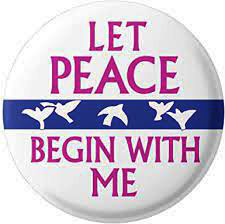 I sang the song that begins, “Let there be peace on earth. And let it begin with me” for years until one day I realized: Yes, peace really does begin with me! I choose what I put out into the world. And those choices can make a huge difference, even if to one person. I am responsible for my responses, whether they come from Lower Ground or Higher Ground. Response-able implies that I have that choice, and what I choose is my response-ability.
I sang the song that begins, “Let there be peace on earth. And let it begin with me” for years until one day I realized: Yes, peace really does begin with me! I choose what I put out into the world. And those choices can make a huge difference, even if to one person. I am responsible for my responses, whether they come from Lower Ground or Higher Ground. Response-able implies that I have that choice, and what I choose is my response-ability.
How can I contribute peace to a difficult situation? Instead of getting angry, or using harsh words, or putting someone in her place, can I stop, breathe, and find another response – a Higher Ground response?
To respond from a place of peace, I need to nurture peace at my center. I need a rocking chair or a “peace place” — real or imagined — where I can go to be calm amidst the chaos of the moment.
I need calm before I can find a way to counter or possibly transform the negativity or overwhelm facing me.
For children who are just forming a view of themselves and the world, my response (or any adult’s response) – Lower Ground or Higher Ground— is magnified through their eyes. Children ask, “Is the world a caring and safe place that values me? Or is it a place as found in the Hunger Games, where caring is absent, and we must compete for our very survival?”
How can we bring our more peaceful selves into our classrooms and allow that calm space within us to radiate out? How can we help our students feel their own calm as they work on their daily projects? This can be especially challenging with certain students who do not yet have the skills to deal with their anger and frustration and tend to act it out instead. We can help these young people find their own peace place.
Nel Noddings, an educator who further developed Carol Gilligan’s “ethic of care,” states that more than leading our classes by rules, though they’re important, we can focus on how we respond to our students. Verbally noticing and reflecting the good things they do back to them, acknowledging their strengths and talents, speaks volumes. We can model the behavior we would like to see in our students and make visible to them how we find a peace place within ourselves. With our empathy, understanding, and appreciation, children can stretch and grow into their best selves.
Noddings,Nel. The Challenge to Care in Schools: An Alternative Approach to Education. (2nd. Ed.). 2005. New York, NY: Teachers College Press.
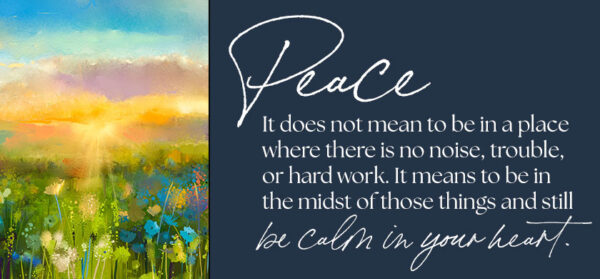
Helping Children Find Their Own Peace through Art
Renee Dauk-Bleess: As Joyce wrote, peace begins with us. We each have the “response-ability” to contribute peace to a situation. As the art teacher for my elementary school, I try to manifest the three building blocks of peacemaking in my classroom:
- Create a physical space that supports and upholds teaching for peace
- Set up a calming atmosphere of peace, using the beauty of nature, music, and the sound of water, and
- Intentionally model and integrate a shared lexicon of peace
Our first peace art project was to design a Tri-fold Name Plate, our first step to find our inner peace. To begin, students folded a standard 8.5’ x 11 sheet of paper into thirds. On Side #1, they wrote their name in the middle of the paper using a favorite color marker. Side #2, they created a one minute free-flowing line design as they listened to beautiful, soft music. Side #3, at the top of the paper, they wrote the sentence “What brings me peace.” Together, we dove into creating that shared lexicon of peace, identifying what peace looks like and feels like to us.
With chart paper at the ready, I asked students: What does peace FEEL like in your bodies? Hesitant at first, a few students started to share. Then more ideas flowed:
Peace feels like …
- You are in the moment
- Safe
- You can breathe
- Happy
- Calm
- Relaxed
- Focused
- Quiet
- Free
- Trust
- You have peace of mind
- Comfortable
I then asked students to think about what peace LOOKS like; to ponder words, images, thoughts, people, places, animals, or experiences that bring them that feeling of PEACE.
Peace looks like …
- Birds chirping in the morning
- Sitting in the sun
- A koi pond
- Hunting
- Fishing
- Playing music
- Family and friends
- The wind
- Waves hitting the shore
- My dog
- Holding a baby
- The sound of a heartbeat
- Looking up at the moon
We took time to share as many ideas as we could. As students brainstormed, our shared lexicon of peace grew stronger.
I wanted students to embody that sense of peace, to internalize it, and to visualize what brings them peace. On Side #3 of our Tri-Fold, I asked them to add three bullet points under the sentence “What brings me peace.” After each bullet point, I asked them to write a word or a phrase, a special person or place, a comforting image or thought, an experience, or an animal that helps bring them peace. Students were encouraged to illustrate these as well.
Finding Peace in Children’s Picture Books
Caren Stelson: Joyce reminded us, peace begins from within, and Renee Dauk-Bleess and her students illustrated what brings them peace on their Tri-Fold Name Plates. Children’s book authors Baptiste Paul and Miranda Paul with illustrator Esteli Meza have followed a similar path. Together they have created the vibrant, rhyming picture book, Peace, that joyfully echoes and adds to Joyce’s and Renee’s ideas.
Peace is on purpose.
Peace is a choice.
Peace lets the smallest of us have a voice.
When we are with friends or enjoying a carefree day, peace can come easily. But when conflict emerges, peace becomes complicated. That’s the moment to stop, take a breath and remember,
“I am responsible for my responses.”
That may also be the moment to reach for the picture book, How to Apologize, by David LaRochelle, illustrated by Mike Wohnoutka. The first sentence is, “Everyone makes mistakes.” What happens after the mistake is up to us. We may need to be response – able and apologize.
But how?
The character Hippo offers two contrasting examples — a Lower Ground and a Higher Ground apology. Apology #1: “… if your ladder wasn’t taking up so much space, I wouldn’t have bumped into it.” Apology #2. “I’m sorry I knocked you over.”
Which apology would you prefer to offer? Which apology would you prefer to receive? Going deeper, what brave apologies can we make or accept that could bring healing, justice and peace into our own lives, our homes, communities and beyond?
Modeling Embodied Gratitude and Inner Peace for Our Students
Ellie Roscher: In 12 Tiny Things: Simple Ways to Live a More Intentional Life, Heidi Barr and I wrote the chapter on HOME as an invitation to gratitude. Embodied gratitude is another way to think about being at inner peace. I lived in fifteen different places between graduating from college and buying my first house. In that transient season, I learned to be grateful for the ever-shifting roof over my head. It was my response-ability to choose gratitude. I also learned to experience a sense of home in my body, in my relationships, and in the present moment as my living quarters changed. Our mantra for the chapter reads: Gratitude, embodied, is to find home within. If we experience our bodies as home, we can live from a place of peace.
Years into home ownership, I do experience home in my house, yes, but I continue to inhabit my body and know it as home as well. Gratitude keeps me awake to the gift of my body and the richness of the present moment. Naguib Mahfouz says, Home is not where you were born; home is where all your attempts to escape cease. There are endless invitations to escape our bodies and dwell in our minds or to escape the present moment to exist in the past or the future. There are endless invitations to get swept up in conflict and live from Lower Ground. It is my response-ability to choose to be mindful of my breath a few times a day, and my breath anchors me in my body and in this moment. It is my peace place. If I were in Renee’s art class, I would draw, “My conscious breath” on my Tri-Fold Name Plate.
With my conscious breath, I more often respond instead of react. This simple practice has grown gratitude for what is within in me and around me. I embody gratitude, which encourages me to be at home wherever my feet are planted, living more often from a Higher Ground and taking my ability to respond seriously. With a collective conscious breath, we can help our students learn to do the same.
_________________________
For each Peace-ology post, Caren, Ellie, Renee, and Joyce partner to learn and explore the meaning of peace by talking and listening with each other. If you’d like to share your ideas about peace, books, and children, please share your comments here, visit our websites, or connect with Joyce and Renee about their Higher Ground work.

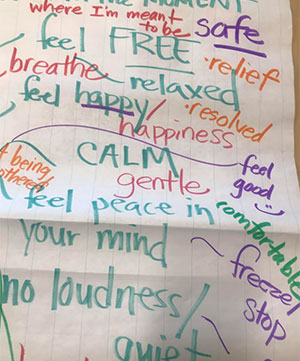
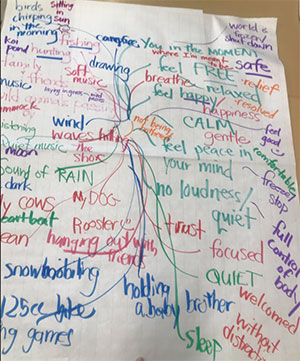
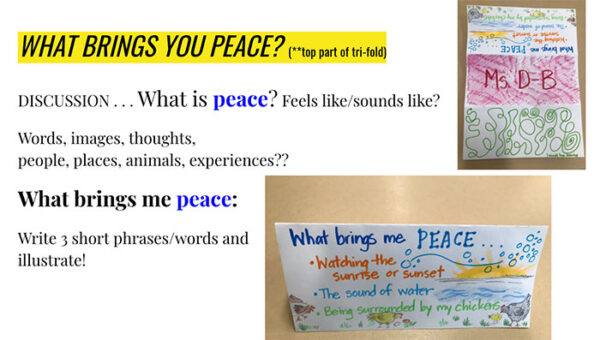
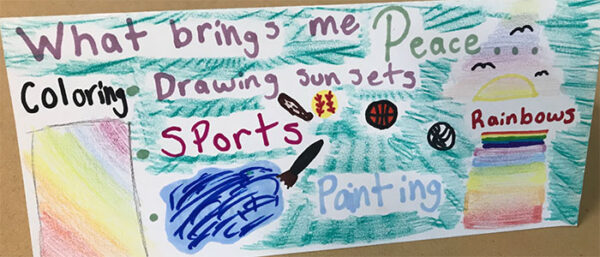

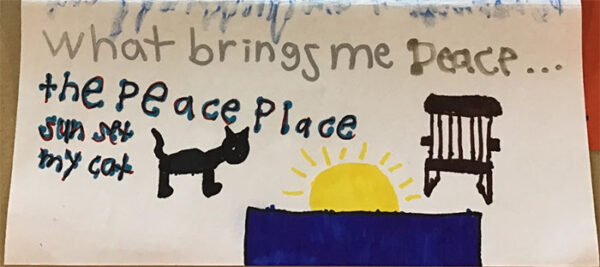
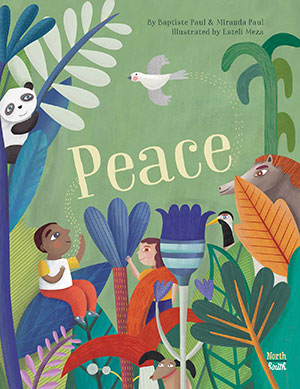
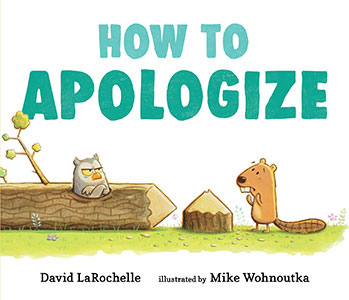

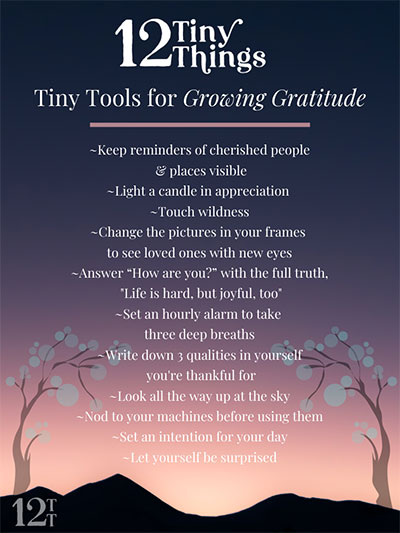
What an honor to have How to Apologize listed with all these other valuable books. Thank you.
David, you are so welcome. I love HOW TO APOLOGIZE. Thank you for writing the picture book and thank you for reading our article. Take good care.